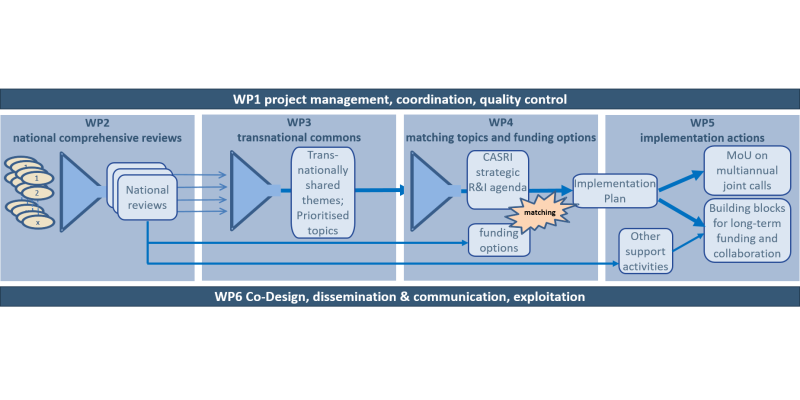The CASRI project is an exciting initiative that brings together Environment Protection Agencies (EPAs) and alike partners from 13 European countries, along with the European Environment Agency (EEA).
The project aims to identify and coordinate Environmental and Sustainability Research and Innovation (ES R&I) needs, to align national ES R&I programmes and to facilitate and converge the application of ES R&I results at both the multilateral and European level in a way that complements existing programmes by the EU and member states.
Collaborate. Innovate. Sustain.
- CASRI unites experts and innovators across Europe to collaboratively address sustainability challenges, diving deep into understanding environmental issues, looking at the bigger picture, and finding ways to make a positive change.
- CASRI is about creating new and innovative ways to address the Global Challenges and Sustainable Development Goals (SDGs) at the national and European level
- CASRI aims to influence and support sustainable policy-making and decision-making, ensuring that research outcomes contribute directly to transformative actions on the ground.
CASRI uses a 'funnelling' approach to gather information. First, our contacts in each participating country collect data on environmental and sustainability research needs and current status. This includes funding opportunities and ways to support the use of research findings. This data is reviewed and organized in workshops, producing reports at the national level.
Next, common themes are identified across countries, related to global challenges and sustainable development goals. We focus on four main themes. This shared research informs our Strategic Research Agenda and funding opportunities.
We then bring together policy-makers and funders to discuss priority topics and funding mechanisms. This could involve joint funding calls or aligning existing programs. Lastly, we lay the groundwork for future collaboration beyond CASRI, allowing new parties to join and updating our agenda accordingly.
hroughout, we engage with funders and policy-makers to stay informed and tackle policy issues in a comprehensive manner. We also collaborate with organizations like the European Environment Agency to ensure our events are inclusive and impactful.
Focus themes covered by CASRI addressing Global Challenges and SDGs
CASRI will assess the environment and sustainability research and innovation (ES R&I) and its application, leaning toward systemic and underscored areas for future research and innovation. In particular, four exemplary themes for the CASRI to align ES R&I have been selected:
- Resilient, net-zero, circular production systems.
- Biodiversity and Climate
- Sustainable urbanisation
- Energy transition
CASRI objectives
To coordinate and improve research and innovation for environment protection and sustainability, focusing on effective solutions with real impact, CASRI will:
- Review national funding and utilization programs for Environmental and Sustainability Research and Innovation (ES R&I), and assess knowledge needs for addressing global challenges and Sustainable Development Goals (SDGs).
- Identify gaps in knowledge transfer, technology development, and societal application of ES R&I findings at national and international levels.
- Establish common priorities in ES R&I needs and challenges across borders, and develop a Strategic R&I Agenda (SRIA) in collaboration with National Key Stakeholders (NKS) and ES R&I funders.
- Explore opportunities for jointly implementing the SRIA alongside existing ES R&I programs.
- Facilitate collaboration among funders of participating Environment Protection Agencies (EPAs) and other European ES R&I funders, aiming to collectively implement the SRIA at different geographical scales.
- Prepare for multi-year collaborative calls among funders, leading to transnational ES R&I projects complementing existing initiatives.
- Undertake joint activities to bridge national and international gaps in knowledge transfer, technology development, and societal application of ES R&I outcomes.
- Enhance long-term collaboration between EPAs and stakeholders in the European Research Area, by laying the groundwork for formalizing the voluntary EPA Network Interest Group EPAS and leveraging existing networks.



